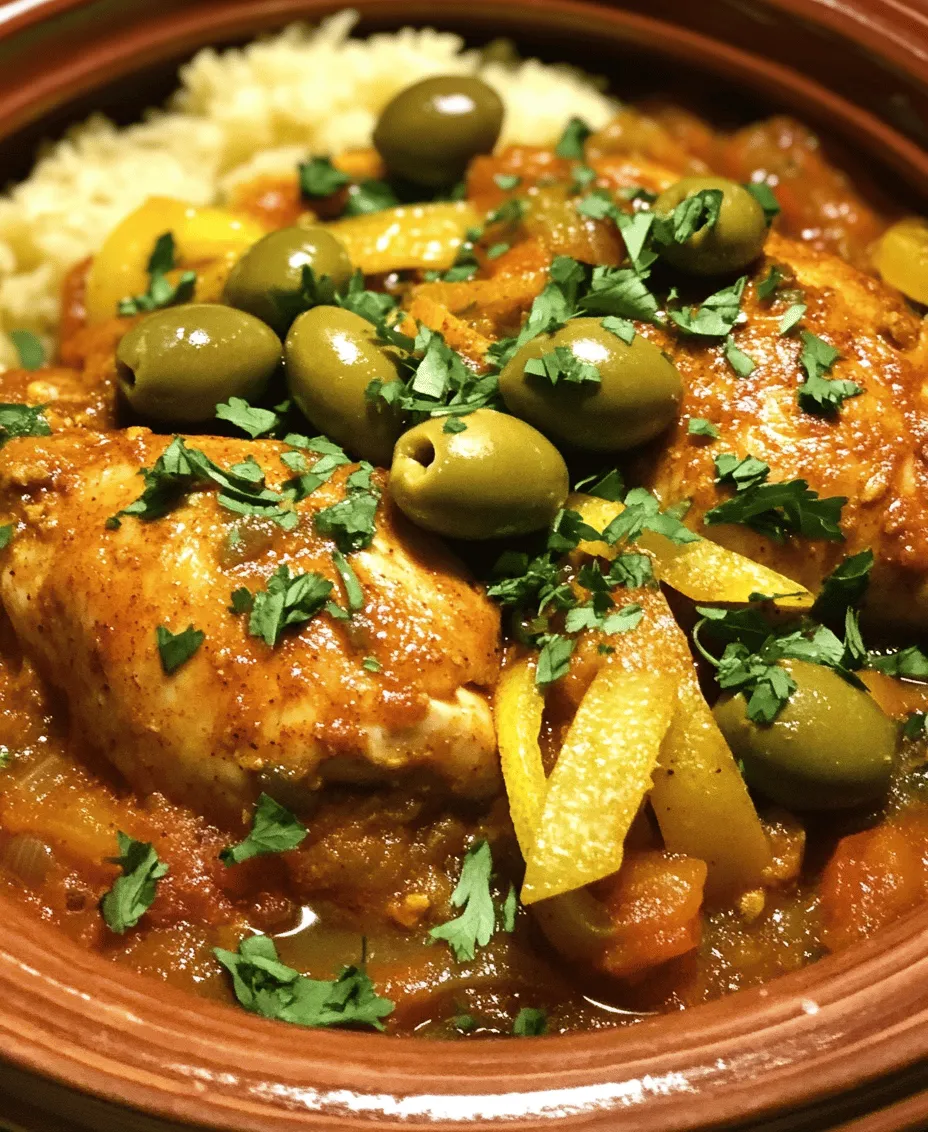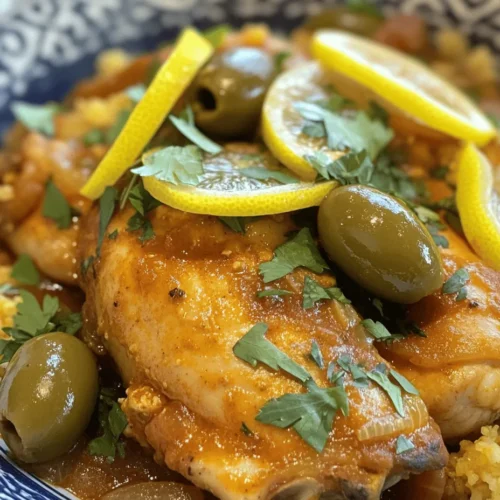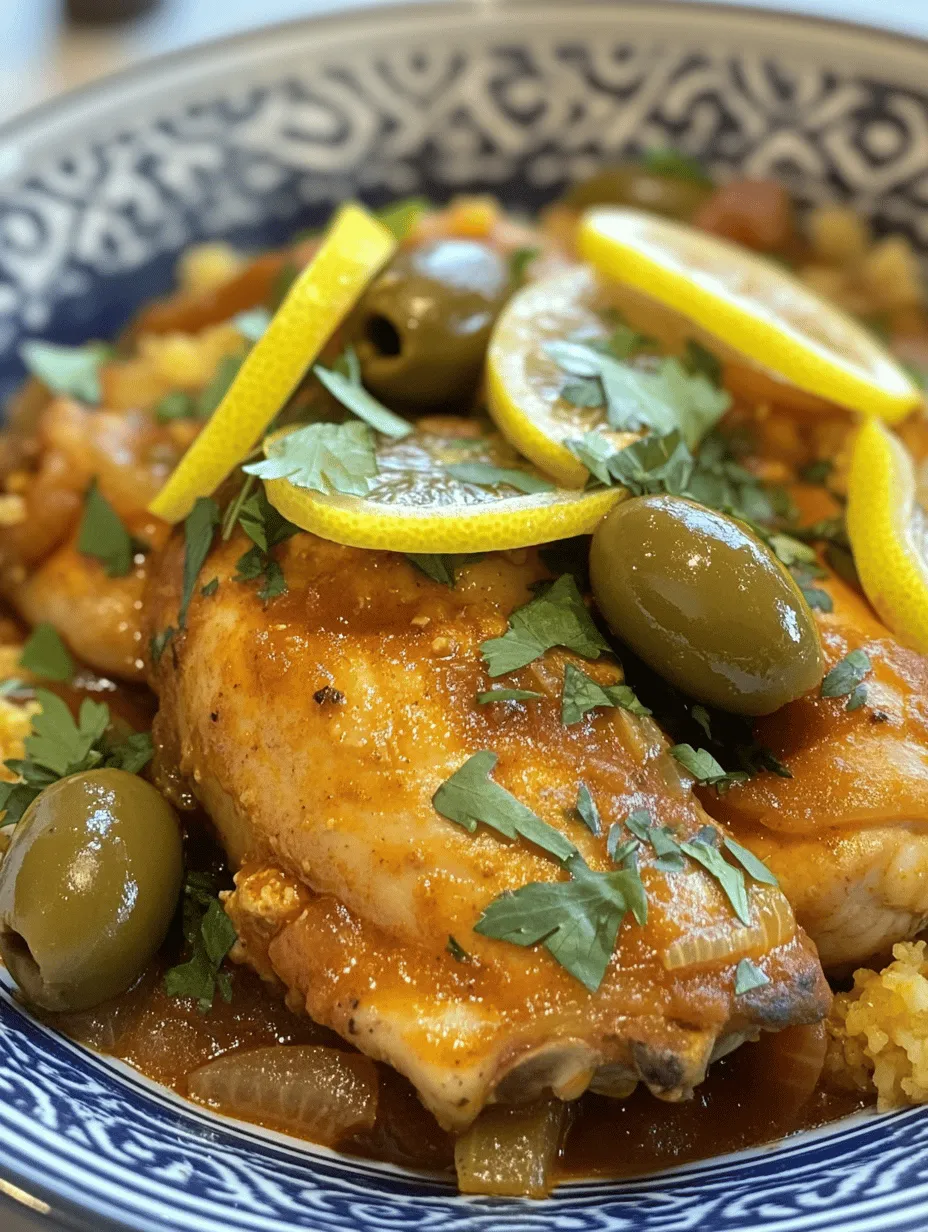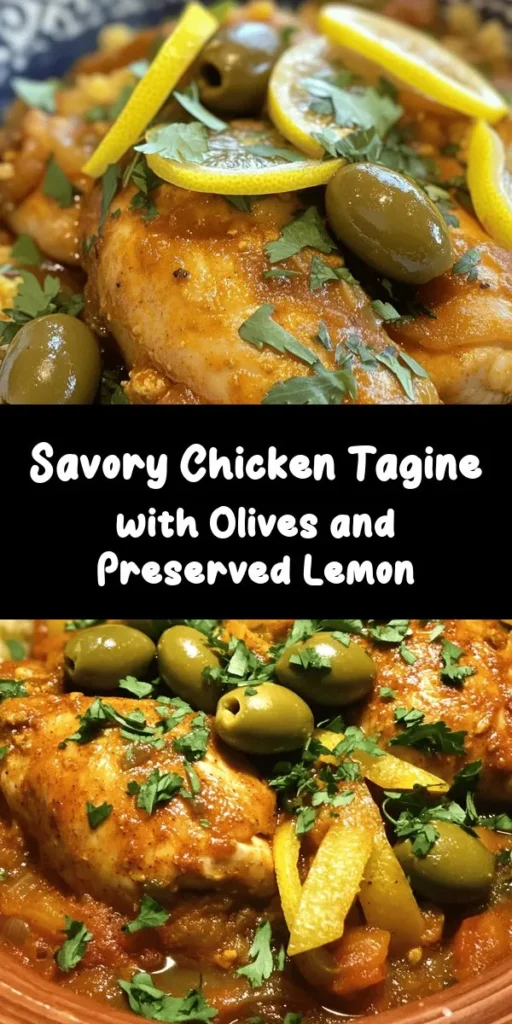Introduction
Explore the rich flavors of Moroccan cuisine with this Aromatic Chicken Tagine with Olives and Preserved Lemons. This dish beautifully combines tender chicken thighs with an array of spices, adding depth and warmth that is characteristic of traditional tagines. Perfect for family gatherings or a cozy dinner, this recipe not only satisfies the palate but also introduces a wonderful cultural experience. The combination of savory chicken, tangy preserved lemons, and briny olives creates a dish that is both complex and comforting, making it a standout choice for any culinary occasion.
In this article, we will dive deep into the history of tagine cooking, the role of each ingredient, and step-by-step instructions to create this delightful dish. Understanding the essence of tagine cooking will enrich your cooking experience and appreciation for this Moroccan classic.
Understanding Tagine Cooking
The Essence of Moroccan Cuisine
Moroccan cuisine is a vibrant tapestry of flavors, colors, and aromas, reflecting the country’s diverse history and culture. The tagine, a traditional North African cooking vessel, plays a central role in this culinary landscape. Made from clay or ceramic, a tagine consists of a shallow base and a conical lid, allowing for moist cooking and enhanced flavors. The design encourages steam to circulate during cooking, which helps tenderize meats and infuse them with the aromas of spices and other ingredients.
Historically, tagine cooking has roots that date back centuries, influenced by Berber, Arab, and Mediterranean cultures. The use of spices is particularly significant in Moroccan cuisine, where they are not just flavor enhancers but also carry cultural importance. Spices such as cumin, coriander, and saffron are often found in Moroccan dishes, bringing warmth and depth to flavors while showcasing the region’s agricultural richness.
The Role of Tagine in Meal Preparation
Tagine cooking emphasizes the art of slow cooking, allowing the flavors to meld beautifully over time. This method of preparation is not only practical but also deeply social. In Moroccan culture, meals are often shared communally, with diners gathering around a tagine placed at the center of the table. This encourages a sense of togetherness and enjoyment of food, making each meal a special occasion.
The communal aspect of sharing a tagine meal adds to its charm. Diners use their hands or pieces of bread to scoop up the flavorful chicken, vegetables, and sauce, creating a tactile and engaging dining experience. This practice fosters connections among family and friends and highlights the importance of hospitality in Moroccan culture.
Ingredients Breakdown
Essential Ingredients for Chicken Tagine
To create a delicious chicken tagine, the choice of ingredients is crucial. In this recipe, we will use chicken thighs, which are favored for their rich flavor and tenderness. Chicken thighs are ideal for slow cooking, as they remain juicy and flavorful compared to other cuts of chicken. For the best results, opt for bone-in and skin-on thighs; the bone adds depth to the broth, and the skin helps retain moisture during the cooking process.
Herbs and Spices: The Heart of the Recipe
The heart of any tagine lies in its spices, and this recipe is no exception. Here’s a detailed breakdown of the spices that bring this dish to life:
– Ground Cumin: This warm and earthy spice is essential in Moroccan cooking, providing a nutty flavor that complements the richness of the chicken.
– Ground Coriander: With its citrusy and slightly sweet notes, ground coriander adds a fresh dimension to the dish, balancing the other spices beautifully.
– Ground Cinnamon: Often associated with sweet dishes, cinnamon also finds its place in savory Moroccan recipes. It imparts warmth and depth, enhancing the overall flavor profile.
– Turmeric: Known for its vibrant yellow color, turmeric offers an earthy, slightly bitter taste, while also providing a host of health benefits. It contributes to the dish’s stunning appearance.
– Smoked Paprika: This spice introduces a subtle smokiness that enriches the dish, making it more complex and inviting.
These spices work in harmony to create a fragrant and flavorful base, transforming the chicken and vegetables into a culinary masterpiece.
The Role of Preserved Lemons and Olives
Two key ingredients that elevate the flavor of this tagine are preserved lemons and olives. Preserved lemons, a staple in Moroccan cuisine, are lemons that have been cured in salt and their own juices. This process intensifies their flavor, making them tangy and aromatic. The bright acidity of preserved lemons cuts through the richness of the chicken, adding a refreshing contrast.
When it comes to olives, Moroccan dishes often feature green or black olives, which add a briny depth to the dish. Their flavor melds beautifully with the spices and chicken, creating a well-rounded taste experience. The combination of preserved lemons and olives is a hallmark of Moroccan cooking, showcasing the country’s love for bold flavors and unique ingredient pairings.
Vegetables and Garnishes
While chicken is the star of this recipe, the addition of vegetables enhances both the texture and flavor. Grated carrots bring a natural sweetness and a pop of color to the dish. They soften during cooking, adding a hint of crunch and balancing the savory elements.
Fresh herbs, such as cilantro and parsley, play an essential role in Moroccan cooking. Not only do they add an aromatic freshness, but they also brighten the dish when sprinkled on top before serving. These herbs lend a vibrant color and further enhance the flavors of the tagine, creating a visually appealing and delicious meal.
Step-by-Step Cooking Instructions
Preparing the Ingredients
Before diving into the cooking process, it’s essential to prepare your ingredients properly. Here are some tips for selecting the freshest ingredients and ensuring they are ready for your tagine:
1. Selecting Fresh Ingredients: When choosing chicken thighs, look for pieces that are plump and have a healthy pink color. The skin should be intact and free of blemishes. For vegetables, select firm carrots with a vibrant color and fresh herbs that have a fragrant aroma.
2. Preparing Chicken Thighs: Begin by rinsing the chicken thighs under cold water. Pat them dry with paper towels to remove excess moisture. This step is crucial for achieving a nice sear when cooking. If desired, you can trim any excess fat, but leaving some on will help keep the chicken juicy.
3. Chopping Onions and Garlic: Finely chop one large onion and two to three cloves of garlic. The onion will add sweetness and depth of flavor, while the garlic will impart a robust aroma.
4. Grating Carrots: Use a box grater to grate two medium-sized carrots. This will ensure they cook quickly and blend seamlessly into the dish.
5. Preparing Spices: Measure out the required spices and have them ready to go. This will streamline the cooking process and help you maintain focus on the task at hand.
6. Curing the Preserved Lemons: If you are using homemade preserved lemons, ensure they are rinsed to remove excess salt before slicing them into thin wedges. If store-bought, check the label for salt content, as some brands may require rinsing as well.
With your ingredients prepared and ready, you’re set to embark on the cooking journey that will result in a delicious and aromatic chicken tagine. This dish not only promises rich flavors but also serves as an invitation to explore the culinary traditions of Morocco. In the following sections, we will guide you through each step of the cooking process, ensuring that you achieve a perfect tagine every time.

Searing the Chicken
Searing the chicken is a crucial step in developing the rich, complex flavors that characterize an authentic chicken tagine. When you brown the meat over high heat, it creates a golden crust that not only enhances the dish’s appearance but also contributes to its overall depth of flavor. This Maillard reaction, which occurs when proteins and sugars in the meat react under high heat, is essential for building a flavor base.
To achieve the perfect golden-brown crust, begin by ensuring your chicken thighs are patted dry with paper towels. Moisture on the surface can prevent proper searing. Heat a tablespoon of olive oil in your tagine or heavy-bottomed pot over medium-high heat until it shimmers. Add the chicken thighs skin-side down, making sure not to overcrowd the pan—this allows for even cooking and a better sear. Let the chicken cook undisturbed for about 5-7 minutes until it forms a nice crust. Flip it over and sear the other side for another 3-4 minutes. Once both sides are golden brown, remove the chicken from the pot and set it aside. This initial searing not only enhances the flavor but also adds a layer of richness to the sauce that will develop later.
Creating the Flavor Base
With the chicken seared to perfection, it’s time to create the flavor base that will define your tagine. Begin by adding a bit more olive oil if needed, and then toss in finely chopped onions. Sauté the onions over medium heat until they become translucent and fragrant, about 5-6 minutes. This step is crucial as it allows the onions to release their natural sweetness, which will balance the savory flavors of the chicken.
Next, it’s time to add your spices. The aromatic blend of spices is key to making this dish memorable. Common spices include cumin, coriander, turmeric, and cinnamon. Adding these spices directly to the pan while sautéing the onions helps to release their essential oils, enhancing the overall flavor profile of the dish. Stir the spices into the onions and allow them to toast for about 1-2 minutes until they become fragrant. This technique ensures that the spices reach their peak flavor, infusing the entire dish with warmth and aroma.
Building and Cooking the Stew
After creating a robust flavor base, it’s important to deglaze the pot. This step involves adding a splash of chicken broth or water to the pan, scraping any browned bits off the bottom. These bits, known as fond, are packed with flavor and will contribute to the complexity of your tagine. Bring the liquid to a brief boil, allowing it to reduce slightly.
Once deglazed, return the seared chicken thighs to the pot. Add in your preserved lemons, olives, and any additional ingredients such as tomatoes or bell peppers you desire. Pour in enough chicken broth to cover the chicken about halfway, ensuring it will simmer well without being submerged. Bring the stew to a gentle simmer, then reduce the heat to low, cover, and let it cook for about 45-60 minutes. This slow cooking process allows the flavors to meld together beautifully while the chicken becomes tender and juicy.
During the simmering process, it’s essential to check the tagine occasionally to ensure it’s not boiling too vigorously. You want a gentle simmer that allows the chicken to cook evenly while the flavors develop without losing moisture. If the liquid level gets too low, feel free to add a little more broth or water as needed.
Garnishing and Serving Suggestions
Once your aromatic chicken tagine is cooked to perfection, it’s time to focus on garnishing and serving. Fresh herbs like cilantro or parsley not only add a pop of color but also provide a fresh contrast to the rich flavors of the dish. Before serving, finely chop your chosen herbs and sprinkle them generously over the top of the tagine.
When it comes to side dishes, traditional Moroccan cuisine often pairs tagine with fluffy couscous or crusty bread. Couscous is particularly popular, as it absorbs the delicious sauce and complements the tender chicken beautifully. To prepare couscous, simply cook it according to package instructions and fluff it with a fork before serving. For a heartier option, consider serving the tagine alongside a simple green salad dressed with lemon vinaigrette to balance the flavors.
Tips for Customizing Your Tagine
One of the wonderful aspects of the chicken tagine recipe is its versatility, making it easy to customize according to your preferences. If you’re looking to experiment with different proteins, consider substituting chicken with lamb or chickpeas for a vegetarian version. Lamb is a traditional ingredient in Moroccan cuisine and will provide a rich, hearty flavor that complements the spices well. For a plant-based alternative, chickpeas can be added for protein, soaking up the flavors of the tagine beautifully.
Adjusting the spice levels is another way to make the dish your own. If you enjoy a bit of heat, consider adding a pinch of cayenne pepper or some sliced green chilies to the mix. On the other hand, if you prefer a milder flavor, reduce the amount of spices or focus on the sweeter spices like cinnamon and cumin.
Incorporating Seasonal Ingredients
The beauty of tagine lies in its adaptability to seasonal ingredients. During the summer months, consider adding fresh vegetables such as zucchini, bell peppers, or eggplant to the stew. In the fall, root vegetables like carrots and turnips can add heartiness and sweetness. Additionally, in the winter, incorporating fruits like dried apricots or prunes can lend a delightful sweetness that complements the savory elements of the dish.
Using seasonal produce not only enhances the flavor but also allows you to enjoy the freshest ingredients available, making your tagine even more delicious and nutritious.
Nutritional Profile of the Dish
Understanding the nutritional benefits of your ingredients can elevate your appreciation for this dish. Chicken thighs, the star protein in this recipe, are an excellent source of protein, essential for muscle growth and repair. They also provide important vitamins and minerals such as B vitamins and iron.
The spices included in the tagine are not just for flavor; they also offer numerous health benefits. For example, turmeric is known for its anti-inflammatory properties, while cumin can aid in digestion. The addition of olives provides healthy fats, rich in antioxidants, and preserved lemons add a burst of vitamin C, promoting overall health.
Cultural Significance of Tagine
The tagine symbolizes more than just a cooking vessel; it represents the essence of Moroccan hospitality. In Moroccan culture, sharing meals is a cherished tradition, and tagine dishes often serve as the centerpiece during family gatherings and celebrations. The communal aspect of eating from a single tagine fosters connection and conversation among diners, making the experience all the more memorable.
Exploring Moroccan culinary traditions reveals the deep-rooted significance of tagine in both festive and everyday life. Many Moroccan festivals feature tagine dishes, highlighting their importance in cultural celebrations. Furthermore, dishes such as pastilla (a savory-sweet pie) and harira (a hearty soup) often accompany tagine, showcasing the diversity of Moroccan cuisine.
Conclusion
In conclusion, the Aromatic Chicken Tagine with Olives and Preserved Lemons is not just a meal; it is an experience that connects you to the rich culinary heritage of Morocco. By understanding the ingredients and techniques involved in making this dish, you can recreate a flavorful and authentic Moroccan experience in your own kitchen. Whether you are a seasoned cook or a novice, this recipe invites you to explore new tastes and aromas, fostering a deeper appreciation for global cuisines. Embrace the opportunity to share this dish with loved ones, creating memories around the table that reflect the warmth and hospitality of Moroccan culture. Enjoy the journey of cooking and savoring this delightful tagine, as it transforms your dining experience into a culinary celebration.



